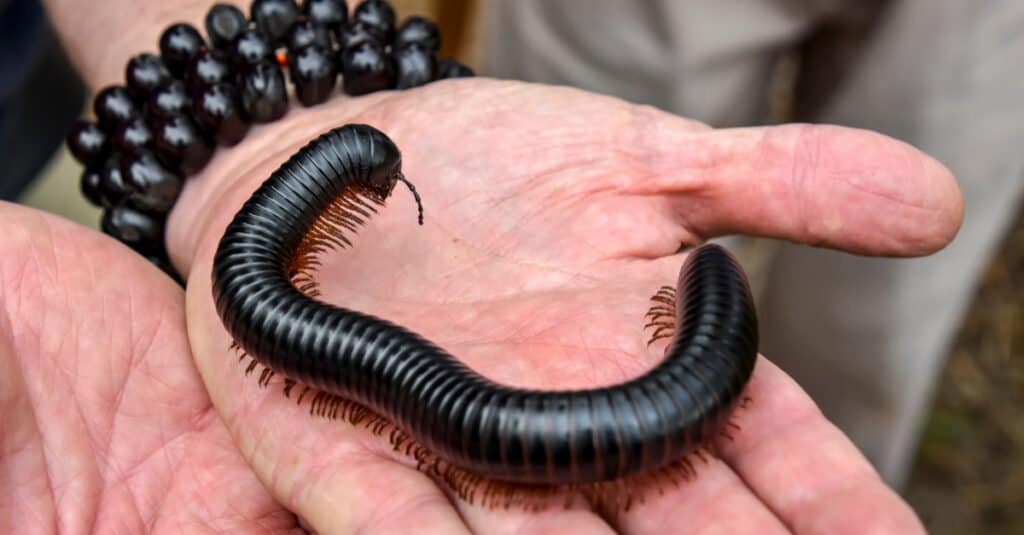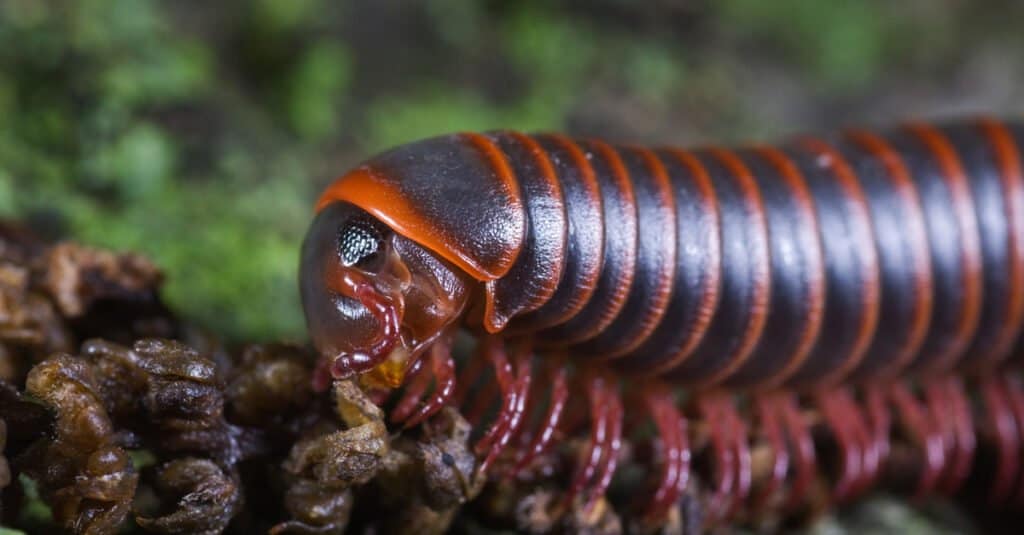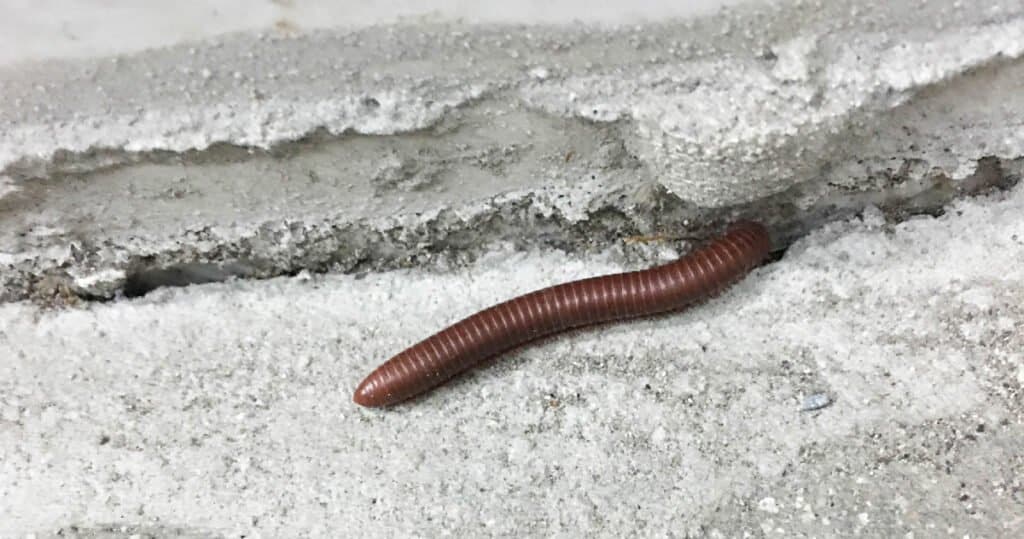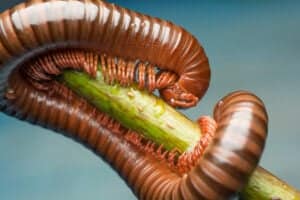Have you ever seen an African giant millipede? From its name, you might be wondering how frightening it could be up close. Millipedes usually give people the creeps, and that’s understandable. They have elongated worm-like bodies with hundreds of legs. Whenever they crawl at you, you can’t help but jump at the touch of their tiny, multiple legs. Have you ever wondered–are millipedes poisonous or dangerous? They may look creepy, yes, but did you know that they are one of the most harmless animals on the planet? Millipedes are not poisonous or dangerous to humans as they do not bite or hurt larger animals. The only way that millipedes can deter predators is by secreting toxins from their body segments to ward them off but not potentially killing them.
Do Millipedes Bite?

Millipedes can not bite with their weak jaws.
©Wandel Guides/Shutterstock.com
Millipedes do not bite or sting. They have very weak jaws that can only consume soft, decaying plant matter, fungi, and flower buds. The muscles in the millipede’s jaws are too weak to bite humans and any other animals, so you wouldn’t worry about them biting you whenever you see or feel them on your skin.
As totally harmless arthropods, millipedes rely on other defense mechanisms to help them deter predators. But are millipedes poisonous to animals? Since they can’t bite, many species of millipedes have glands that secrete toxins or irritating fluids. These toxins produced by the millipede contain hydrochloric acid capable of chemically burning the skins of some animals. Larger species of millipedes can spray these toxins from a distance of 32 inches or 80 centimeters whenever they detect a threat.
However, these toxins can have a lasting unpleasant odor for humans when sprayed on the hands. This can be harmless to many, but some people may be allergic to these toxins like in other animals. Millipede toxins can somehow, though rarely, trigger some reactions from allergic people.
Are Millipedes Dangerous to Humans?

Known to be very passive and timid, millipedes pose no danger to humans.
©Gerry Bishop/Shutterstock.com
Generally, millipedes are not dangerous to humans. Millipedes are known to be very passive and timid, and they would never attack humans. Apart from the fact that they cannot bite or sting, millipedes are naturally not aggressive. Millipedes move very slowly and coil or curl their bodies into a ball whenever they are provoked. However, millipedes do not just crawl on land without any self-defense system.
When they feel threatened by humans or hunted by predators, these worm-like bugs secrete a harmful substance or toxin from the segments of their bodies. These toxic substances, with the foul odor they produce, can ward off predators. The toxins produced by millipedes are often not poisonous or harmful for humans, but they can trigger allergic reactions in a few people.
The millipede toxin comprises various chemicals that can trigger some allergies. It consists of the following substances:
- Hydrochloric acid
- Benzoquinones
- Cresols
- Phenol
- Hydrogen cyanide
- Organic acids
- Hydroquinones (in some species of millipedes)
Because of the chemical substances included in a millipede’s toxic spray, some people may develop some symptoms of allergic reactions when handling one. Toxins produced by millipedes can cause blisters, burning or itching, staining, or skin discoloration. The fluid secreted or sprayed can also irritate the eyes, so it is recommended not to handle millipedes with your bare hands. If you do, you have to ensure that you wash your hands afterward to get rid of whatever toxin they may have produced.
Since millipedes also secrete a foul odor as an act of self-defense, people may also notice a lingering smell on their hands after handling a millipede. Alcohol, soap, and water will immediately remove the pungent smell and help eliminate the toxins. When crushed, millipedes can also release these toxins, so you may not want to touch or kill them when you see one.
Are Millipedes Poisonous?

Toxins secreted by millipedes are not poisonous.
©asawinimages/Shutterstock.com
The toxins that millipedes secrete when threatened are not poisonous to anyone or anything. Unlike centipedes, millipedes are neither poisonous nor venomous and do not threaten humans and other animals. The largest species of millipedes, the African giant millipede, grows up to 15 inches. Despite their seemingly monstrous facade, they are one of the most harmless animals on Earth.
Centipedes and millipedes are often compared due to their similar appearances, names, and numerous legs. While millipedes have more legs than centipedes, their key difference is their defense mechanism. Centipedes will run fast when threatened, and when cornered, they will bite as their last resort. Centipede bites can be extremely painful, and their venom can trigger several complications.
On the other hand, millipedes will either try to run away at a slow pace or will curl up in a ball to protect their soft undersides. Despite their hundreds of legs, millipedes move very slowly and will not harm you once they reach your skin. However, when startled or handled roughly, millipedes release toxins. This toxic secretion can affect the millipede’s predators such as ants, spiders, and other insects but will only trigger some mild allergies to humans. Although it doesn’t normally kill the predators, it is foul-smelling and strong enough to keep millipedes out from unwanted attention.
Are Millipedes Poisonous to Dogs?

The toxin secreted by a millipede can irritate a dog’s mouth.
©Vach cameraman/Shutterstock.com
Millipedes are not poisonous to any animal, including dogs. Dogs do not belong to the millipede’s list of main predators, but since most dogs are curious and like exploring, they can sometimes poke and eat millipedes. The millipede is not toxic to dogs, and there are no known millipede species that can poison dogs. However, the toxic substances or chemicals released by millipedes can irritate a dog’s mouth. Once eaten, millipedes can also give off an unpleasant odor accompanied by a displeasing taste that can cause discomfort. You can rinse your dog’s mouth after they accidentally eat a millipede to get rid of the unpleasant taste.
How to Avoid Millipedes
Millipedes do not cause any serious harm, especially when left alone. If you don’t want to get secreted with foul-smelling and irritating fluids, all you need to do is refrain from touching or handling house millipedes. Do not crush them either, as they can release toxins while getting crushed.
The photo featured at the top of this post is © dwi putra stock/Shutterstock.com
Thank you for reading! Have some feedback for us? Contact the AZ Animals editorial team.







